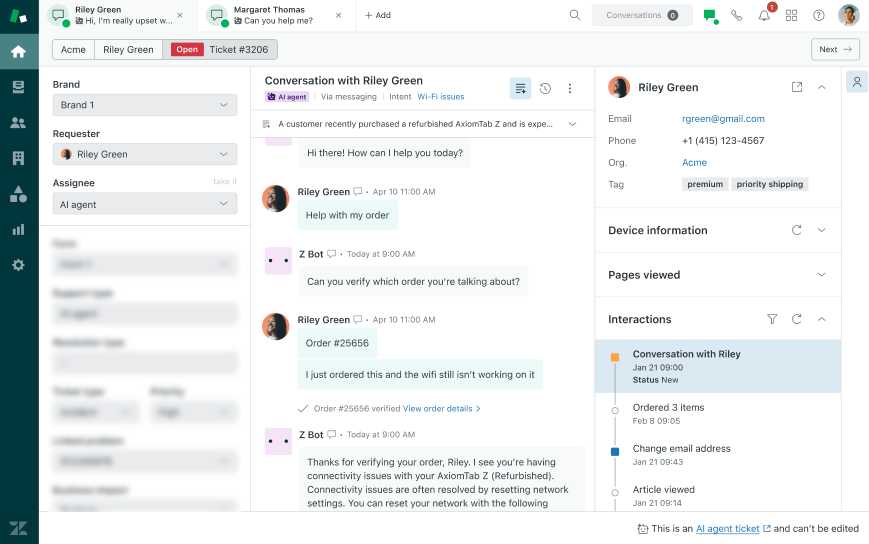Structuring for Success: A Guide to Customer Support Team Models

Customer support is far more than a cost center; it's a vital engine for business growth. Exceptional support drives customer satisfaction, builds loyalty, and can turn satisfied customers into vocal advocates. Statistics underscore this reality: customers increasingly expect fast, seamless assistance across multiple channels. How a business organises its support team is fundamental to meeting these expectations. Yet, many organisations, particularly those experiencing growth, grapple with finding the optimal structure. An ill-fitting model can breed inefficiency, frustrate support agents, and ultimately lead to poor customer experiences.
This guide explores three common approaches to structuring a customer support team: the Generalist model, the Specialised model (often enhanced by omnichannel routing), and the Tiered Generalist model. Understanding the mechanics, benefits, and drawbacks of each, along with key considerations for choosing the right fit, can empower businesses to build a support function that truly serves both the customer and the company.
The All-Rounder: The Generalist Support Model
The Generalist model is often the default starting point, particularly for smaller organisations. In this structure, each support agent is equipped to handle virtually any type of customer inquiry that comes their way, acting as a versatile "jack-of-all-trades". As illustrated below, the customer interacts with a single agent who attempts to resolve the issue directly.

Agents in this model typically possess broad knowledge across various facets of the business, products, or services.
Example: Consider a small e-commerce business selling handmade crafts. A generalist support agent might handle inquiries about order tracking, process returns, answer basic questions about materials used, and troubleshoot website login issues.
Pros:
- Simplicity & Cost-Effectiveness (Especially for Small Teams): This model is relatively straightforward to manage initially. For startups or small businesses with limited resources or lower inquiry volumes, hiring versatile generalists can be more budget-friendly than employing multiple specialists. One agent can cover diverse needs, maximising resource utilisation on a small scale.
- Versatility & Flexibility: Generalist agents develop a wide range of skills and can adapt to different tasks or cover for colleagues, ensuring service continuity. They are often adaptable and willing to learn new skills, readily taking on new challenges as the business evolves.
- Smoother Initial Experience (Potentially): For straightforward issues, the customer journey can be seamless, with one agent handling the inquiry from start to finish without complex handoffs or navigating intricate phone systems
Cons:
- Lack of Deep Expertise: The breadth of knowledge required often comes at the expense of depth. Generalists may possess only surface-level understanding of complex or niche topics, potentially struggling to resolve intricate issues effectively or providing less accurate solutions. This can lead to escalations, negating the model's simplicity, or result in subpar support quality compared to a specialist.
- Scalability Challenges: As a company grows, products become more complex, or inquiry volume increases, the generalist model can struggle to scale. Training agents across an ever-widening range of topics becomes increasingly difficult and time-consuming.
- Potential for Burnout & Lower Efficiency on Complex Tasks: Constantly switching between diverse inquiry types can decrease workflow efficiency. Agents may feel overburdened taking on multiple functions, leading to potential burnout. They might also require more supervision, especially when tackling unfamiliar or complex problems.
- Training Burden: While generalists are adaptable, ensuring they have adequate, up-to-date knowledge across all necessary areas demands significant and continuous training investment.
A critical factor influencing the suitability of the Generalist model is the complexity of the product or service offered. While generalists excel with broad knowledge, they often lack the specialised depth needed for intricate problems. For businesses offering relatively straightforward products, like apparel or basic consumer goods, generalists can likely handle the vast majority of customer inquiries effectively.
However, when dealing with complex offerings, such as sophisticated software (SaaS), technical hardware, or services with many variables, the generalist's lack of deep expertise quickly becomes a bottleneck. Agents may frequently encounter the limits of their knowledge, leading either to necessary escalations (which undermines the model's inherent simplicity) or, worse, to incorrect or incomplete answers that frustrate customers. Therefore, businesses must realistically evaluate their product complexity and the anticipated nature of support requests before adopting a generalist approach, even if the team is small.
Divide and Conquer: The Specialised Support Model (Powered by Omnichannel)
In contrast to the generalist approach, the Specialised model structures the support team around specific areas of expertise. Agents or teams focus on distinct categories of issues, such as technical support, billing inquiries, product feature guidance, or onboarding assistance.
A crucial element often paired with this model, as depicted below, is Omnichannel Routing.

Omnichannel routing is more than just offering multiple contact methods (multichannel); it involves integrating these channels into a unified system. When a customer inquiry arrives through any channel – be it phone, email, live chat, social media, or SMS – an intelligent routing system directs it to the agent or team possessing the specific skills needed to address that issue. Critically, this system provides the agent with the customer's complete interaction history and context, regardless of previous channels used. This eliminates the common frustration of customers having to repeat their problem multiple times as they switch channels or agents.
Example: A financial software company might have specialised teams for tax calculation queries, investment platform support, account security issues, and mobile app troubleshooting. A customer initiating a chat about a suspected security vulnerability would be automatically routed by the omnichannel system to the account security team. That team would receive the chat transcript along with the customer's account details and recent activity logs, allowing for an immediate and informed response.
Pros:
- Deep Expertise & High-Quality Resolutions: Specialists develop profound knowledge within their domain, enabling them to resolve complex or technical issues more quickly and accurately. This is particularly valuable for businesses with intricate products or services.
- Increased Efficiency (for Specialists): By handling similar types of inquiries repeatedly, specialists become highly efficient and adept at resolving issues within their area of focus.
- Enhanced Customer Experience (via Omnichannel): The seamless transition between channels, consistent service delivery, and agents equipped with full context significantly improve customer satisfaction and foster loyalty. It reduces customer effort and makes interactions feel more personalised.
- Agent Development & Growth: Clear areas of specialisation provide structured pathways for agents to deepen their expertise, potentially leading to career advancement and increased job satisfaction.
Cons:
- Requires Robust Routing Technology: Effective specialisation hinges on sophisticated omnichannel routing platforms (often integrated within CRM or dedicated helpdesk software like Zendesk). Implementing and maintaining these systems can be complex, costly, and require technical expertise. Overcoming integration complexities and breaking down data silos between systems are common hurdles.
- Potential for Silos: Without proactive management and fostering collaboration, specialised teams might become isolated, focusing narrowly on their area and potentially hindering cross-functional knowledge sharing.
- Resource Planning Complexity: Accurately forecasting inquiry volume for each specialty is crucial for appropriate staffing levels and ensuring workloads are balanced across teams. This model can also create dependencies on specific key individuals or teams.
- Higher Initial Cost: Hiring specialists typically commands higher salaries than hiring generalists. Coupled with the significant investment required for omnichannel technology, the initial setup cost for a specialised model can be substantial.
The successful implementation of a specialised support structure is intrinsically linked to the effectiveness of its underlying omnichannel routing system. While specialisation offers depth of expertise, without a mechanism to seamlessly connect these specialised agents and provide them with context, the customer experience can become fragmented and frustrating.
Imagine a customer chats with a billing specialist, then later emails about a related technical glitch. Without omnichannel integration, the technical specialist receives the email in isolation, lacking the context from the earlier chat. The customer is forced to explain their situation again, leading to inefficiency and annoyance. Conversely, a well-implemented omnichannel system ensures the technical specialist sees the previous interaction history, enabling a smooth, informed, and efficient resolution. The routing logic itself ensures the query efficiently reaches the right specialist in the first place. Therefore, the investment in and complexity of omnichannel technology should be viewed not as an optional add-on, but as a foundational requirement for realising the customer experience benefits of a specialised support model.
Level Up: The Tiered Generalist Model
The Tiered Generalist model, often simply called the Tiered model, introduces a hierarchical structure to handle customer inquiries based on complexity. Issues typically enter the system at the lowest tier (Tier 1) and are escalated to higher tiers only when necessary.

Example: A telecommunications company might use Tier 1 for basic billing questions and service activation. Tier 2 could handle network connectivity troubleshooting and modem configuration. Tier 3 might involve network engineers diagnosing widespread outages or complex infrastructure problems escalated from Tier 2.
Pros:
- Efficiency & Resource Optimiation: This model excels at handling high volumes by filtering simple requests at lower, often less expensive tiers. This reserves the time of highly skilled (and costly) experts for genuinely complex problems, optimising resource allocation. It systematically matches issue complexity with agent expertise.
- Scalability: The structure is inherently scalable. As the business grows, companies can add more agents to existing tiers or further refine tier responsibilities to manage increased volume and complexity. It also simplifies identifying hiring needs for specific skill levels.
- Clear Escalation Path & Consistency: It provides a well-defined process for handling issues of increasing difficulty, ensuring problems don't get lost. Standardised procedures within tiers can promote service consistency.
- Potential for High FCR (at Tier 1): A well-equipped and trained Tier 1 team can resolve a substantial portion of inquiries on the first contact, improving overall efficiency and customer perception for common issues.
- Structured Training & Career Progression: The model allows for targeted training programs focused on the specific knowledge needed for each tier. It also offers a clear pathway for agents to develop skills and advance to higher tiers.
Cons:
- Risk of Poor Handoffs & Customer Repetition: A major pitfall is the potential for customers to be bounced between tiers, forced to repeat their issue and context with each new agent. This creates significant frustration and negates efficiency gains from the customer's perspective. Efficient, seamless escalation is crucial but challenging to execute perfectly.
- Potential for Silos & Limited Knowledge Sharing: Tiers can operate in isolation, limiting opportunities for lower-tier agents to learn from experts and potentially trapping valuable knowledge about complex issues within higher tiers.
- Tier 1 Quality/Morale Risk: If Tier 1 is viewed merely as a low-cost filter, agents may handle repetitive tasks with limited scope for skill development. This can lead to low morale, burnout, high turnover, or subpar first interactions if agents are undertrained or disengaged. The sheer volume of basic inquiries can also lead to Tier 1 agents feeling overworked.
- Slower Resolution for Complex Issues: By design, issues requiring Tier 3 expertise must first pass through Tiers 1 and 2. This sequential process can delay the resolution for complex problems compared to a model where the issue is routed directly to a specialist.
The Tiered model presents a fundamental trade-off. Its core strength lies in operational efficiency and optimised resource allocation. By filtering issues, it aims to use expert time wisely. However, this internal optimisation can clash with the customer's experience if not managed carefully. The primary criticisms center on the friction created by escalations – customers repeating themselves, delays for complex issues getting to the right expert.
The model implicitly assumes that efficient internal filtering will lead to a satisfactory overall experience. Yet, if the filtering and escalation process itself is flawed – characterised by poor handoffs, inadequately trained Tier 1 agents unable to meet resolution benchmarks, or slow internal processes – it damages the customer journey. The customer feels like they are being processed through a bureaucratic system rather than receiving personalised support. Success hinges on minimising the friction between tiers. This requires investing in robust Tier 1 training (focusing on effective resolution, not just cost reduction), establishing clear and efficient escalation protocols, diligently monitoring performance indicators like First Contact Resolution, Average Resolution Time, and Escalation Rate, and potentially leveraging technology (like shared CRM notes or even internal omnichannel principles) to ensure context travels seamlessly with the escalated issue. The focus must remain on effective, timely resolution for the customer, not just on the tiered processing itself.
Finding Your Fit: Which Support Structure is Right for You?
There is no single "best" customer support structure; the optimal choice is highly contextual and depends entirely on a company's unique circumstances. Selecting the right model requires a thoughtful assessment of business needs, customer expectations, available resources, and strategic goals.
To guide this decision, businesses should consider the following questions:
- Business Size & Stage: Is the organisation a small startup with nascent support needs or a large enterprise managing significant volume? What is the anticipated volume of support requests?
- Product/Service Complexity: How intricate are the company's offerings? Do common customer issues require deep technical knowledge, specialised skills, or troubleshooting expertise?
- Customer Base & Expectations: Who are the primary customers? Are they generally tech-savvy or do they prefer more guided assistance? What are their expectations regarding support speed, personalisation, and channel availability? What defines an ideal, "delightful" support experience for these customers?
- Budget & Resources: What financial resources are available for staffing the support team and investing in necessary technologies like CRM systems, helpdesks, or advanced omnichannel platforms?
- Support Team Skills: What skills, expertise levels, and potential training needs exist within the current team or among potential new hires?
- Strategic Goals: What are the primary objectives for the customer support function? Is the focus on minimising costs, maximising customer satisfaction (CSAT), improving customer retention, facilitating upselling, or gathering product feedback?
The table below provides a high-level comparison to aid in evaluating these factors against the different models:
|
Feature |
Generalist Model |
Specialised (w/ Omnichannel) Model |
Tiered Generalist Model |
|
Best For |
Small teams; Simple products/services; Low volume |
Complex products/services; High-value support needs; Diverse channels |
High volume; Varied issue complexity; Scalability needed |
|
Key Benefit |
Simplicity; Initial cost-effectiveness (small scale) |
Deep expertise; High-quality resolution; Enhanced CX (via omnichannel) |
Operational efficiency; Scalability; Resource optimization |
|
Main Challenge |
Lack of depth; Scalability limits; Potential burnout |
High cost (staff & tech); Implementation complexity; Potential silos |
Handoff friction; Customer repetition; Tier 1 quality/morale |
|
Scalability |
Low to Moderate |
High (requires technology investment) |
High |
|
Tech Requirement |
Basic Helpdesk/CRM desirable |
Advanced Omnichannel Platform & CRM essential |
Helpdesk/Ticketing system essential; CRM beneficial |
|
Agent Skill Profile |
Broad; Versatile; Adaptable |
Deep; Specialised; Focused |
General (T1) + Increasingly Specialised (T2/3+) |
The answers to the guiding questions can point towards the most suitable structure. For example:
- A small startup with a straightforward product and limited budget might initially thrive with a Generalist model.
- A company with a highly complex SaaS product, a significant budget for technology, and customers demanding expert help across multiple channels might lean towards a Specialized model enabled by robust omnichannel routing.
- A rapidly growing business facing a high volume of inquiries with varying complexity might find the Tiered model offers the necessary efficiency and scalability.
It's also important to recognise that structures can be hybrids, or they can evolve. A company might start with generalists and transition to a tiered or specialized model as it grows and its needs change.
Conclusion: Structure for Success
Choosing a customer support structure is a critical decision that directly impacts customer satisfaction, operational efficiency, and employee engagement. The Generalist, Specialized (with Omnichannel), and Tiered models each offer distinct advantages and disadvantages. The "right" choice is not universal but depends on a careful evaluation of the business's specific context – its size, product complexity, customer base, budget, and strategic objectives.
Ultimately, the goal is to implement a structure that enables the team to deliver consistently positive customer experiences in an efficient manner. This requires aligning the chosen structure with the company's unique definition of "customer delight". Furthermore, the selected structure should not be considered static.
As the business grows and evolves, the support organisation must adapt alongside it. Continuous monitoring of key performance indicators, gathering feedback, and a willingness to refine processes are essential for long-term success. Investing in the right tools, clear procedures, and ongoing training and support for the agents themselves is paramount to making any chosen structure function effectively.
By thoughtfully designing and actively managing its support organisation, a business can transform customer service from a simple necessity into a powerful competitive advantage.


